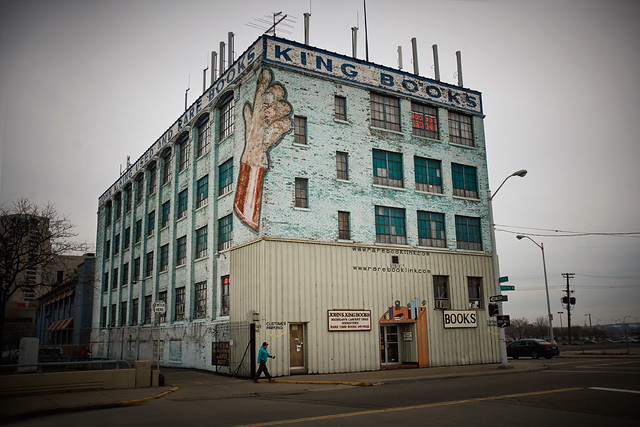
Photo by Flickr user Roche Photo.
John K. King Used & Rare Books hardly needs an introduction to any readers in Metro Detroit. Located in a former four-story factory at Lafayette and the Lodge Expressway for thirty years, the million-book collection is the biggest in Michigan and among the largest in the United States. John King Books has long been popular destination for local bibliophiles as well as tourists.
This is the story of the building it now occupies, the land on which it sits, and how the massive structure was moved 250 feet sixty-six years ago to its present location.
The Land
This block was part of the ribbon farm which DeGarmo Jones purchased in 1821 and owned until his death in 1846. Jones' widow, Catherine H. (Annin) Jones, subdivided the farm south of Michigan Avenue into blocks, lots, streets and alleys in 1851. Mrs. Jones reserved one block--bounded by Fort Street, Lafayette Boulevard, 4th St. and 5th St--for a palatial mansion that she had built soon afterward. The home, set in the center of the block, appears the 1853 map of the city drawn by Henry Hart. Mrs. Jones died in 1865.
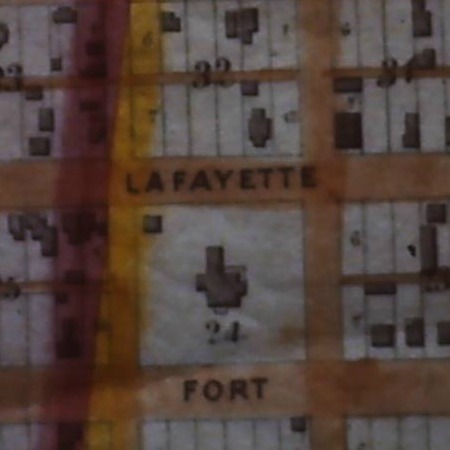
The Jones Mansion block in 1853.
By the 1880s, this block had come to be owned by the Connecticut Mutual Insurance Company. In September of 1882, this company paid the contracting firm Wellington & Coughlin to move the mansion from the center of the block toward Fort Street so that an alley could be added and the rest of the block divided into individual lots for sale. It was on two of these northerly lots that the future home of John K. King Books would be built.
As for the mansion, it was sold, renovated, and reopened as the Detroit Sanitarium. The Sanitarium was more or less a private hospital that treated chronic ailments, but not contagious diseases. It was moved to Providence Hospital on West Grand Boulevard in 1914, and the building was converted into a hotel.
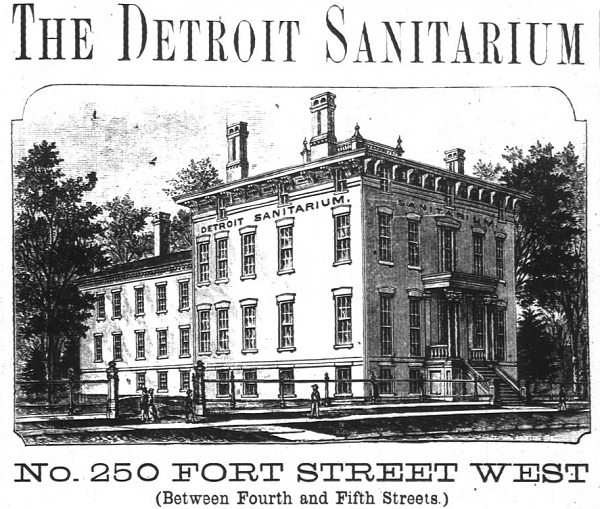
Advertisement in an 1884 Detroit city directory.
William A. Moore, a local attorney for the Connecticut Mutual Insurance Company, subdivided the block into twelve 50-foot-by-130-foot lots in 1889. When the Detroit Museum of Art was in search of a site for a permanent institution in 1884, the Connecticut Mutual Insurance Company offered to sell five of the six lots on the north side of this block for $40,000 (over $1 million today, adjusted for inflation). A different site was chosen, and these lots sat vacant for several years.
A New Factory for Edson, Moore & Company
James L. Edson, George F. Moore, and Ransom Gillis founded their dry goods (fabric and clothing) wholesale business, Edson, More & Co., in 1872. By 1898, the company was producing their own "shirtwaists" (blouses) as the Ste. Claire Manufacturing Company, first operating out of a shared industrial space on Porter and Fourth Street.
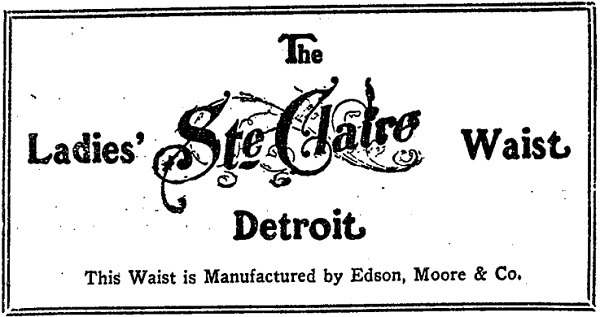
Advertisement from a 1905 newspaper.
The business continued to grow until it became necessary to build its own factory. The Detroit Free Press of January 8, 1905 announced:
For the new building that is to be erected for the Ste. Claire Manufacturing Co., corner of Fourth street and Lafayette avenue, Architects Stratton & Baldwin have let the following contracts: Mason work, J. B. Le Reau & Co.; carpenter work, Harcus & Lange; steel work, H.B. Lewis; painting, Fred Ramford & Co.; roofers, Hartman & Scharf; plumbing, S. H. Morgan. The new building is to be 50x130 feet, four stories high, with a full cellar.A few years later, the architects--William Buck Stratton and Frank Conger Baldwin--would go on to design the Pewabic Pottery studio on East Jefferson Avenue. In 1917, Mr. Stratton married Mary Chase Perry, a co-founder of Pewabic Pottery.
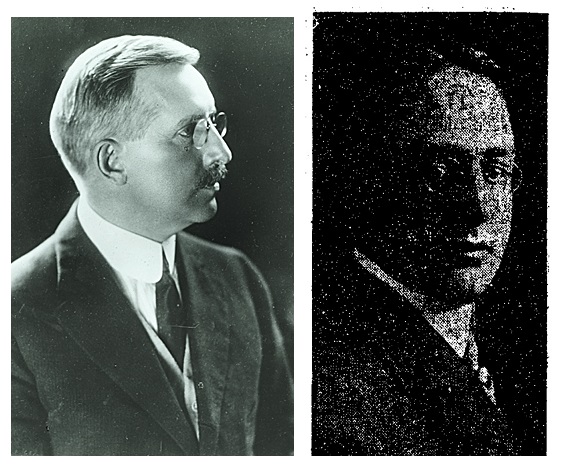
Architects William B. Stratton (source) and Frank C. Baldwin (Det. Free Press 9/20/1908).
The site selected for the factory was the southwest corner of Lafayette Boulevard and Fourth Street--lot #1 of the former Jones Mansion block, also known as the William A. Moore subdivision. The building permit was issued to the general contracting firm LeMay & Whelan (Nelson Le May and Charles J. Whelan), according to the March 19, 1905 edition of the Free Press. The estimated cost of construction was $23,000.
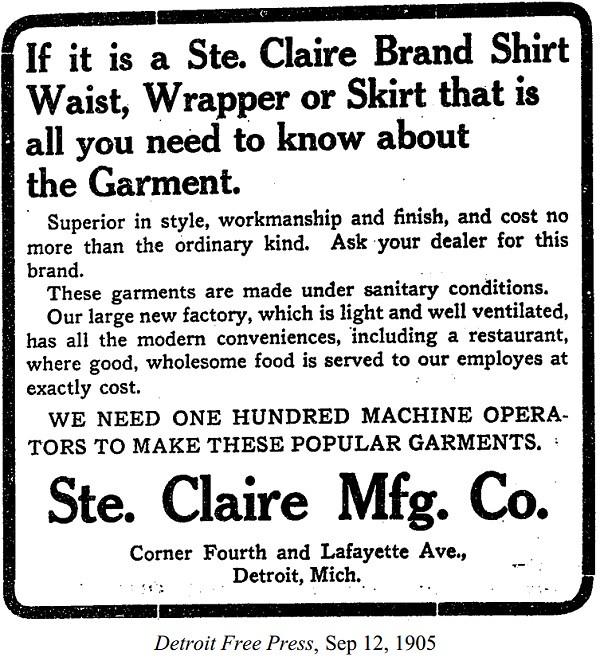
Within months of opening, the new factory was praised by inspector Mary Girardin of the Michigan Bureau of Labor in a report dated November 30, 1905:
Two hundred girls are working in the new factory of the Ste. Claire Manufacturing Company here and they have fine facilities for the care of their employes. In the basement is a cafe where they are served with noon day lunches at cost prices. The company takes a decided interest in its employes and has found that it was an excellent business investment. (Source.)
The December 20, 1905 edition of the Detroit merchants' weekly journal, simply entitled Trade, remarked:
Some years ago the large demand for ladies shirtwaists, wrappers, etc. made it necessary for the firm [Edson, Moore & Co.] to start a factory of their own for the manufacture of this class of merchandise. This venture has proved a large and thriving business in itself. Last year they erected their new factory, corner Lafayette avenue and Fourth street. This is the most complete factory of its kind in the middle west, being a five-story building, mill construction, employing three hundred to three hundred and fifty people. The product of this company is distributed not only in this territory but throughout the entire west. The factory is run as a separate organization under the name of the Ste. Clair Mfg. Co. (Source.)
Although Edson, Moore & Co. continued to do business for years, the Ste. Claire Manufacturing line seemed to disappear just a few years after the opening of the factory on Lafayette and Fourth. 1908 is the last year that they are listed at this address.
National Color Co. & Crown Hat Manufacturing Co.
Following the departure of Ste. Claire Manufacturing, the building was occupied by two affiliated businesses: Crown Hat Manufacturing Co. and National Color Co., both founded by Arthur Drury Mitchell. Crown Hat Manufacturing began in 1902, first producing ladies' hats on Park Place just north of Michigan Avenue. The building on Lafayette and Fourth was a branch factory for the company at least as early as 1908, and became its sole manufacturing center soon afterward. The National Color Co., incorporated in 1909, manufactured dyes especially for milliners. It was initially listed at a building farther west on Lafayette Boulevard, but the company appeared at this address by 1910.
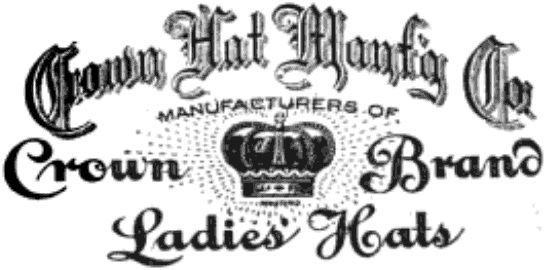
(Source.)
Although Crown Hats were made in Detroit, the company's flagship store was at 604 Broadway in New York City. The photograph below depicts their New York showroom as it appeared in 1909.
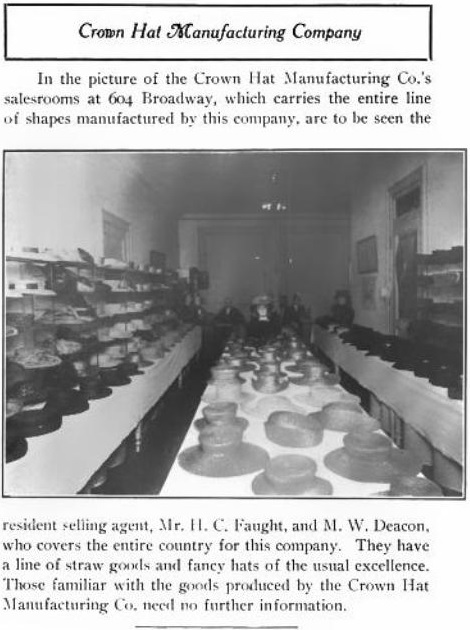
(Source.)
The image below, taken from a 1910 edition of The Illustrated Milliner, displays some of the items made in the Crown Hat Manufacturing Company's Detroit factory.
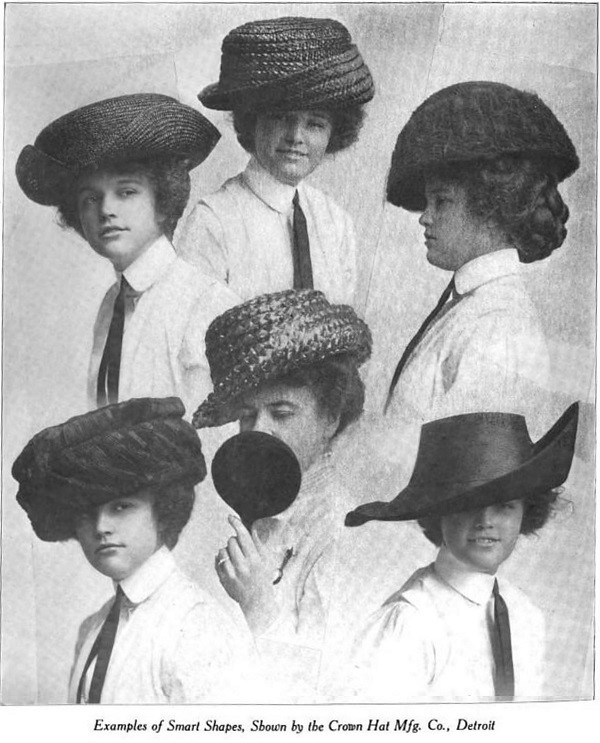
(Source.)
On January 11, 1912, a factory immediately to the south of the Crown Hat Mfg. Co., which housed the Chamberlin Metal Weatherstripping Co., was destroyed by fire. The Crown Hat building is barely discernible in the background on the left hand side of the photo below.
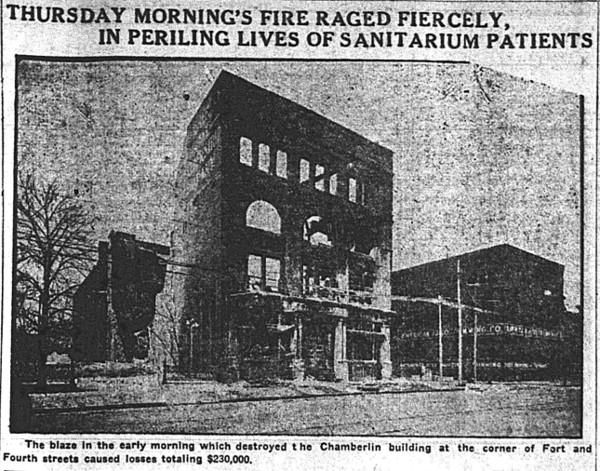
Source: Detroit Free Press, January 5, 1912.
Crown Hat experienced a fire of its own on December 29, 1914, believed to have been due to faulty wiring. Although it was contained to the top floor and extinguished before it could spread, stock on the lower levels were damaged by water and 250 employees were put out of work. The company was protected by an insurance policy and made a full recovery.
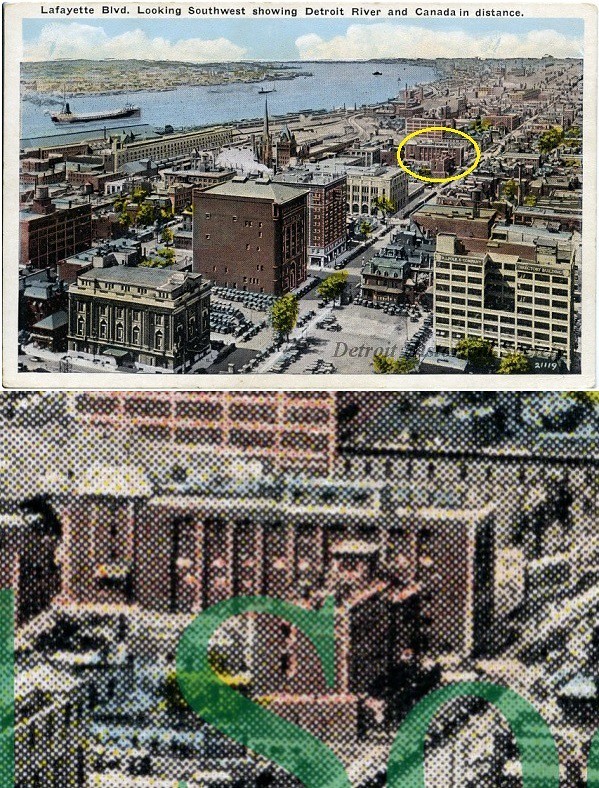
A postcard depicting Lafayette Boulevard, Detroit, circa 1917. (Source.)
The image below, taken from the 1922 Sanborn fire insurance maps, shows the factory in its original location. The Jones mansion/Detroit Sanitarium had been turned into a hotel by that point, and most of the block was still empty.
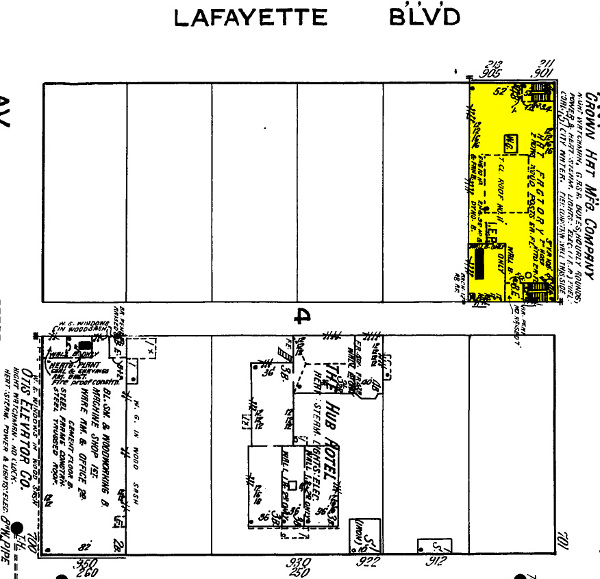
Ultimately, the Crown Hat Manufacturing Company fell victim to the Great Depression, becoming bankrupt in May of 1930. The 1931 directory lists the factory as vacant, which it remained for several years.
Advance Glove Manufacturing Company
The founder of Advance Glove Manufacturing, Joseph Frenkel, was born in the Ukraine in 1899 and immigrated to the U.S. in 1921. In 1929, he started the company at the corner of Russell Ave and Vernor Highway. The operation later moved to a five-story building Jefferson Avenue between Woodward and Griswold, but it burned completely in a spectacular fire on May 10, 1937. It moved again to 1040 West Fort Street before finally settling at 901 West Lafayette in the 1940s.
The company expanded with factories in Ohio, Illinois and Georgia, and manufactured other safety and industrial clothing, such as welding aprons and firefighter suits.

Floor mat still at the entrance of the building.
Photo by Flickr user Kodamakitty.
The Big Move
The factory had sat where it was built for more than four decades. But as the United States entered the disastrous urban renewal frenzy of the mid-20th century, this happened:
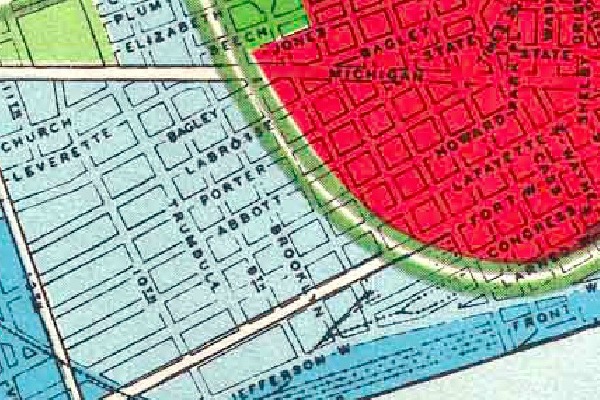
A Detroit Plan Commission map showing the proposed route of the Lodge Expressway.
Image courtesy Detroit Historical Museum. (Source.)
One of the first freeways to be built in Detroit was the John C. Lodge Expressway, and the Advance Glove factory stood in its path. The construction of this freeway, which began in January 1947, destroyed thousands of homes and buildings in the city. But the Advance Glove factory was spared, and was instead jacked up and rolled 250 feet westward in 1948, from the corner of Lafayette and Fourth Street to the corner of Lafayette and Fifth Street.
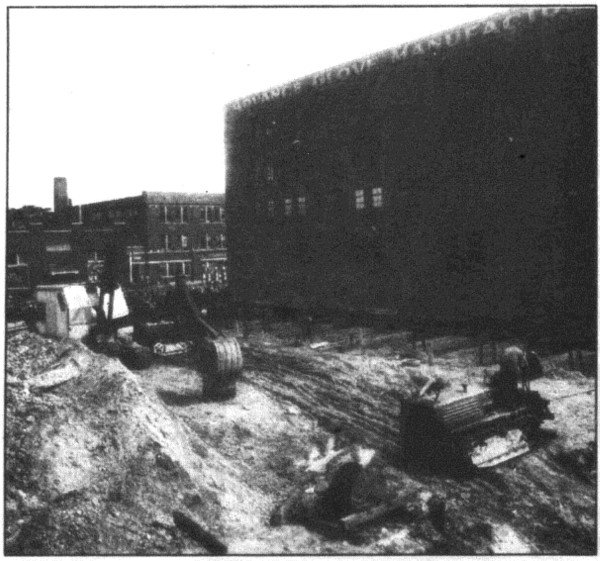
Work crews prepare to move the Advanced Glove building in 1948.
Source: Detroit Free Press, September 19, 1994.
Work in the factory was not interrupted by the building's move. According to Ted Oresky, who worked on the project and was quoted in a 1994 article in the Detroit Free Press about John King Books, the factory was moved on log-like rollers made of Alabama gum wood.
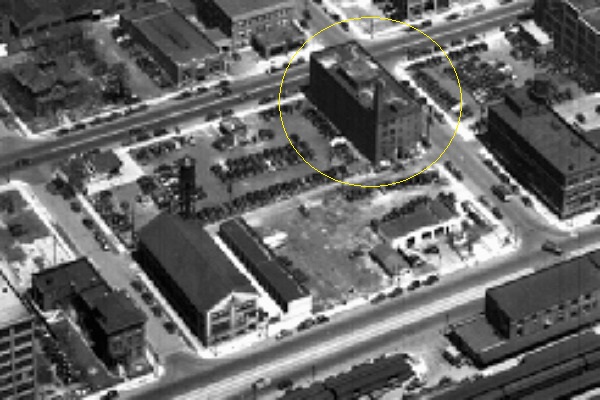
The future home of John K. King Books in 1936. (Source.)
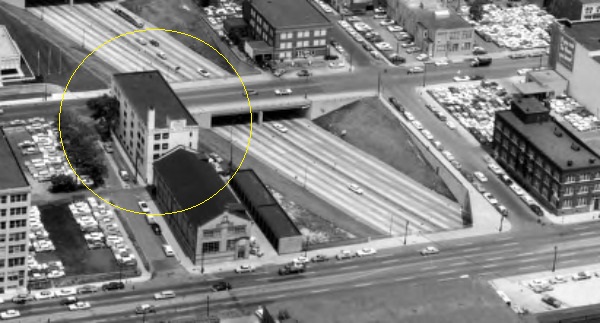
The same block in 1962, fourteen years after the building was moved. (Source.)
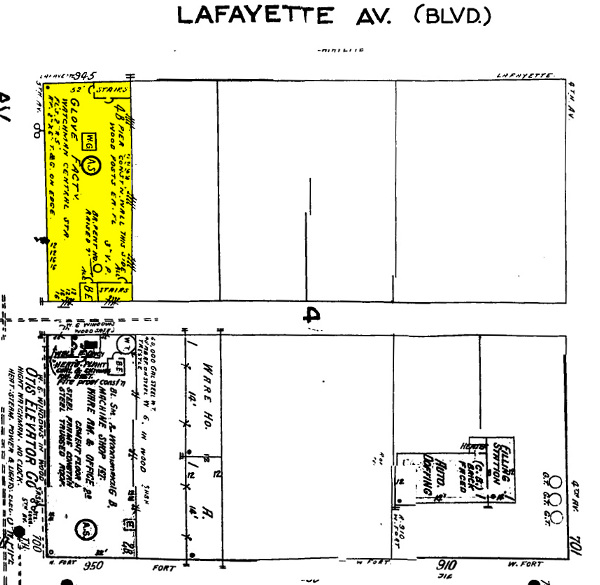
The factory at its new location. Image courtesy Sanborn maps.
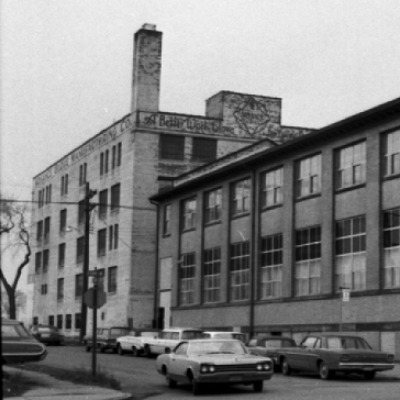
The Advance Glove factory, behind the Otis Elevator building, in 1966. (Source.)
On March 19, 1981, the Advanced Glove Manufacturing Company filed for chapter 11 bankruptcy. The following November 30, the case was converted to chapter 7 and the company's assets were liquidated.
John K. King Books
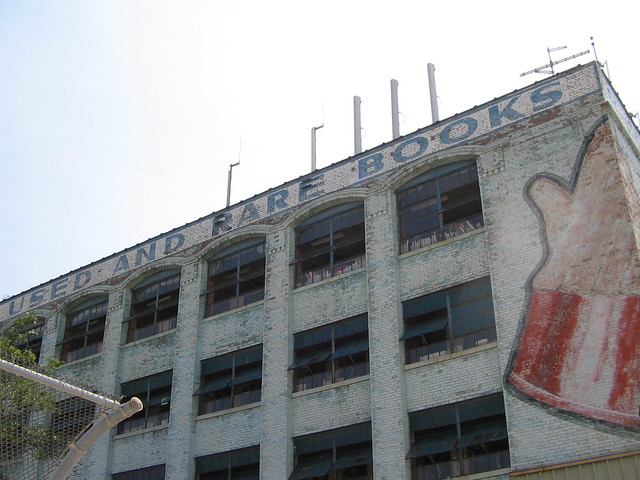
Photo by Flickr user Salticidae.
John K. King got into the book business in 1965, first at a small shop downtown and briefly expanding into a store in Dearborn. When the Dearborn store was not successful, he returned downtown, opening a store in the Michigan Theater Building on Bagley Street. Twelve years later, having outgrown that location, Mr. King asked an employee of his to search classified ads for a new location for the business. The former Advance Glove Manufacturing Co. was listed among the ads, and it happened to suit his needs. Mr. King purchased the building in 1983 and opened his new location on January 1, 1984.

Photo by Flickr user MarkinDetroit.
Indications that this building was once a glove factory are scattered throughout the building. A large painting of a glove on the structure's facade remains intact. A rubber floor mat reading "Advance Gloves" is still at the building's entrance. The factory's wood-paneled offices on the first floor have been stuffed with books and incorporated into the retail floor space. Many signs admonishing workers "NO SMOKING IN PLANT" remain hanging above the bookcases.
Mr. King outgrew even this building, and his collection has spilled over into another former factory, located immediately to the south of the former factory on Lafayette. This second building, which houses more rare collections that are seen by appointment only, was constructed in 1909 by the Vinton Company for the Otis Elevator Company of New York. Before being purchased by Mr. King, it housed the architecture firm Eberle M. Smith Associates for several decades.
John K. King Used & Rare Books is located at 901 West Lafayette Avenue in Detroit, and is open 9:30am to 5:30pm Monday through Saturday.
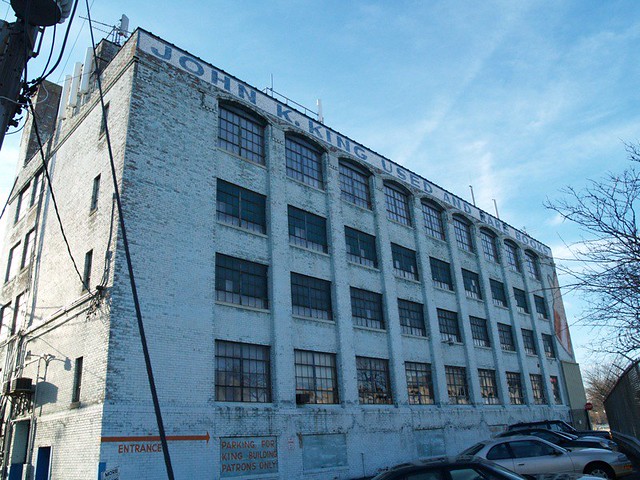
Photo by Flick user danepstein.
